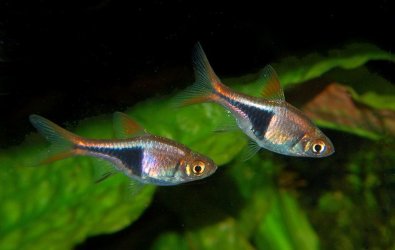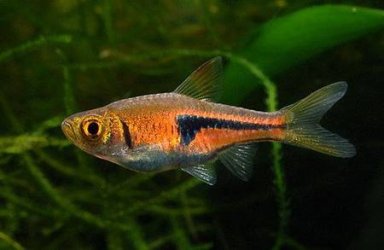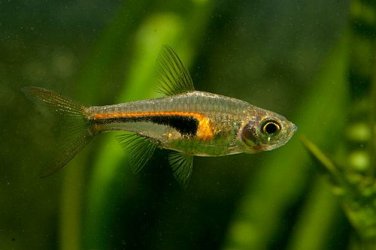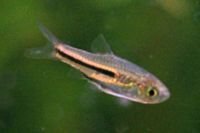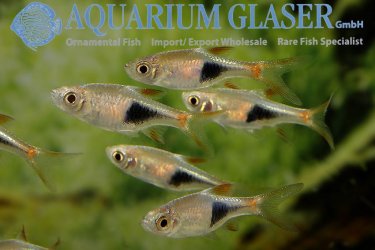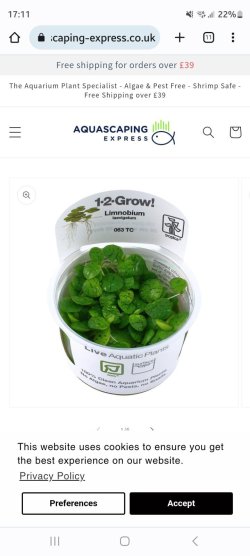You are using an out of date browser. It may not display this or other websites correctly.
You should upgrade or use an alternative browser.
You should upgrade or use an alternative browser.
Any nice footage of Lamb chop rasboras?
- Thread starter rebe
- Start date
One must be careful with common names, since they are not always commonly used. I suspect by "lambchop" you are referring to Trigonostigma espei, but in local stores I have frequently seen this name applied to a close relative, T. hengeli. I'll give you some data on these fish, and photos.
As a result of their study of some of the cyprinid fishes, Kottelat & Witte (1999) erected the new genus Trigonostigma for this and the three closely-related species [a fifth species is now described, more below]. This name is from the Greek trigonon (=a triangle or hatchet) and stigma (=a spot or brand). T. heteromorpha is the type species for the genus. This separation was made on the basis not only of the striking similarity in colour and pattern, but more on the spawning method that differs from all other rasbora; in these species, the female attaches the eggs to leaves, usually on the underside, and the male comes along to fertilize them. Other species of rasbora are egg scatterers. Subsequent studies (Liao et.al. 2010, and others) have confirmed this division on the basis of phylogenetics. No one has disputed that this genus is monophyletic, i.e., the species are all descended from a common ancestor.
T. heteromorpha is the largest species of the five, usually just under two inches/five cm, and well known in the hobby as the Harlequin Rasbora. T. espei and T. hengeli are very similar, but the shining copper spot on the latter is indeed stunning in a dimly lit aquarium. Both attain 1.6 inches/4 cm. A fourth species in the genus, T. somphongsi, has a dark broad stripe [rather than a triangular mark] that runs laterally below an iridescent stripe; this species occurs in the basin and floodplain of the Menam River in Thailand and is very rare. A fifth species, T. truncata, was described by H.H. Tan in 2020 and in appearance is more like T. heteromorpha than the other species in the genus. Photos of the five below.
All these fish must have a good cover of floating plants to subdue the light and make them shine. They will tend to remain mid-level, and in a group. A group of more than 10 is advisable, closer to 12-15, especially important for T. espei and T. hengeli. Very peaceful, not known to fin nip and thus work well with sedate fish like many of the gourami.
As a result of their study of some of the cyprinid fishes, Kottelat & Witte (1999) erected the new genus Trigonostigma for this and the three closely-related species [a fifth species is now described, more below]. This name is from the Greek trigonon (=a triangle or hatchet) and stigma (=a spot or brand). T. heteromorpha is the type species for the genus. This separation was made on the basis not only of the striking similarity in colour and pattern, but more on the spawning method that differs from all other rasbora; in these species, the female attaches the eggs to leaves, usually on the underside, and the male comes along to fertilize them. Other species of rasbora are egg scatterers. Subsequent studies (Liao et.al. 2010, and others) have confirmed this division on the basis of phylogenetics. No one has disputed that this genus is monophyletic, i.e., the species are all descended from a common ancestor.
T. heteromorpha is the largest species of the five, usually just under two inches/five cm, and well known in the hobby as the Harlequin Rasbora. T. espei and T. hengeli are very similar, but the shining copper spot on the latter is indeed stunning in a dimly lit aquarium. Both attain 1.6 inches/4 cm. A fourth species in the genus, T. somphongsi, has a dark broad stripe [rather than a triangular mark] that runs laterally below an iridescent stripe; this species occurs in the basin and floodplain of the Menam River in Thailand and is very rare. A fifth species, T. truncata, was described by H.H. Tan in 2020 and in appearance is more like T. heteromorpha than the other species in the genus. Photos of the five below.
All these fish must have a good cover of floating plants to subdue the light and make them shine. They will tend to remain mid-level, and in a group. A group of more than 10 is advisable, closer to 12-15, especially important for T. espei and T. hengeli. Very peaceful, not known to fin nip and thus work well with sedate fish like many of the gourami.
Attachments
Really interesting, you are so knowledgeable! You are correct, I did mean Trigonostigma espei.One must be careful with common names, since they are not always commonly used. I suspect by "lambchop" you are referring to Trigonostigma espei, but in local stores I have frequently seen this name applied to a close relative, T. hengeli. I'll give you some data on these fish, and photos.
As a result of their study of some of the cyprinid fishes, Kottelat & Witte (1999) erected the new genus Trigonostigma for this and the three closely-related species [a fifth species is now described, more below]. This name is from the Greek trigonon (=a triangle or hatchet) and stigma (=a spot or brand). T. heteromorpha is the type species for the genus. This separation was made on the basis not only of the striking similarity in colour and pattern, but more on the spawning method that differs from all other rasbora; in these species, the female attaches the eggs to leaves, usually on the underside, and the male comes along to fertilize them. Other species of rasbora are egg scatterers. Subsequent studies (Liao et.al. 2010, and others) have confirmed this division on the basis of phylogenetics. No one has disputed that this genus is monophyletic, i.e., the species are all descended from a common ancestor.
T. heteromorpha is the largest species of the five, usually just under two inches/five cm, and well known in the hobby as the Harlequin Rasbora. T. espei and T. hengeli are very similar, but the shining copper spot on the latter is indeed stunning in a dimly lit aquarium. Both attain 1.6 inches/4 cm. A fourth species in the genus, T. somphongsi, has a dark broad stripe [rather than a triangular mark] that runs laterally below an iridescent stripe; this species occurs in the basin and floodplain of the Menam River in Thailand and is very rare. A fifth species, T. truncata, was described by H.H. Tan in 2020 and in appearance is more like T. heteromorpha than the other species in the genus. Photos of the five below.
All these fish must have a good cover of floating plants to subdue the light and make them shine. They will tend to remain mid-level, and in a group. A group of more than 10 is advisable, closer to 12-15, especially important for T. espei and T. hengeli. Very peaceful, not known to fin nip and thus work well with sedate fish like many of the gourami.
I was just checking out my tank to see how the floating plants were doing and a couple of them had gone brown and mushy over night. Removed those, and since I've temporarily moved all of the frogbit (Limnobium laevigatum) into a little plastic 2.5 litre tank. (Not heated or filtered). I have been trying to figure out what the problem was and from what I've read online it seems like surface movement or temperature could be the problem. Previously I did remove a few of the loose leaves that had turned yellow/brown but they had transitioned from yellow to brown whereas the ones that had died over night were green yesterday and mushy brown today. Not sure what went wrong, so I thought moving them into the plastic tank would remove two of the potential causes (heat/movement) and I could see if they would perk up again.
In videos of people's tanks with floating plants like frogbit or duckweed, it seemed like their tanks had none or very little surface movement. I don't think my tank is high flow, but there aren't any spots on the surface that are completely still either. So I'm thinking maybe the amount of surface movement might mean that my tank isn't really suited for floating plants like the frogbit. I trimmed the tops of some of the hornwort (ceratophyllum demersum), and those seem to be doing the best out of all my plants. The trimmings could grow out at the water's surface and act like floating plants but I don't know if that would be good enough for the rasboras mentioned in your reply. They could also just clump into a corner and be of no use to fish who need surface cover.
Maybe I should look into fish that don't need surface cover and like a fair bit of surface movement? I'm not sure.
The issues with the floating plants could be something else entirely. Maybe the levels of ammonia, nitrites and nitrates leeching from the aqua soil. I could also consider removing some or all of the air stones, maybe switch to a sponge filter. But I've heard that flow and oxygenation are important also.
The reason I was looking at the Trigonostigma espei is because I would really enjoy a school of small/nano/micro fish with tight schooling behaviour. From what I've read and seen on Youtube so far, rummy nose tetras and harlequin/lambchop rasboras seem to have the best schooling behaviour.
My ideal school of fish would be 2 cm or under (the individual fish, and the smaller the better) and would swim around together in a school. I don't want a shoal of fish that would just inhabit the same tank/general area. Before I was considering ember tetras but from what you've said before, they can be quite shy and need good surface coverage from floating plants. This is probably wishful thinking, and I doubt there are any fish of that size and behaviour that my tank could suit. I do like the colouring and size of the chilli rasbora, but I can't quite tell if these fish properly school or whether they shoal.
My reason for wanting a school of fish that are small in size is so that I can keep a bigger school together, (and still have enough room for a centrepiece fish or maybe a cleaner like the whiptail catfish you suggested) and for there be enough space for them to live comfortably without being crammed.
Do you or anybody have any suggestions or advice?
TNG
Fish Crazy
A short clip of the espei (hope the link works), they are in a 55G tank with the gouramis, yo-yo loaches and 5-banded barbs.
They swim everywhere and only really school right after I change the water. I have a HOB Seachem Tydal 55, but I don’t think they really care whether I have a HOB, internal filter or air stones.
They swim everywhere and only really school right after I change the water. I have a HOB Seachem Tydal 55, but I don’t think they really care whether I have a HOB, internal filter or air stones.
I had frogbit in my main tank. The water flow made them circle round the tank until they grew so much they got log jammed. The reason I no longer have frogbit is that not only did I have to remove handfuls every water change to leave some surface clear but the roots grew so long they tangled with the lower down plants so the roots had to be trimmed every week. This is what my frogbit turned into
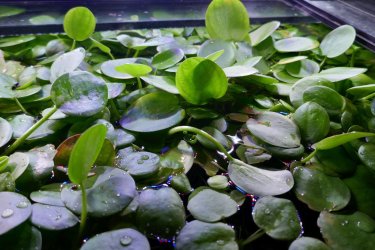
I tried water sprite, but that doesn't do well in this tank. Once the leaves (fronds?) reached more than 3 inches/7.5 cm they just wilted. I do still have a few baby water sprite but once they grow and wilt they'll be removed, though I will remove the baby plants before they go.

I tried water sprite, but that doesn't do well in this tank. Once the leaves (fronds?) reached more than 3 inches/7.5 cm they just wilted. I do still have a few baby water sprite but once they grow and wilt they'll be removed, though I will remove the baby plants before they go.
Are you absolutely certain your frogbit is limnobium laevigatum and NOT hydrocharis morsus-ranae? They are almost indistinguishable but the latter (european frogbit) is a temperate plant and (at least in the UK) cultivated in outdoor ponds. This tends to die in tropical temps and does not cope well with the humidity inside a tank. I had several unsuccessful attempts at keeping it, including some sold under the name limnobium laevigatum.
Then I got wise to this and bought branded tissue cultured plants (in my case Tropica brand) I had no problems and it grows like @Essjay describes, even though there is a lot of surface movement, which I have introduced because of the log jam effect, and high humidity. I happen to like those long roots so I do take out buckets of the stuff every week and trim the roots when they get too long.
Then I got wise to this and bought branded tissue cultured plants (in my case Tropica brand) I had no problems and it grows like @Essjay describes, even though there is a lot of surface movement, which I have introduced because of the log jam effect, and high humidity. I happen to like those long roots so I do take out buckets of the stuff every week and trim the roots when they get too long.
The packaging said limnobium laevigatum but apart from that I have no idea if they actually areAre you absolutely certain your frogbit is limnobium laevigatum and NOT hydrocharis morsus-ranae? They are almost indistinguishable but the latter (european frogbit) is a temperate plant and (at least in the UK) cultivated in outdoor ponds. This tends to die in tropical temps and does not cope well with the humidity inside a tank. I had several unsuccessful attempts at keeping it, including some sold under the name limnobium laevigatum.
Then I got wise to this and bought branded tissue cultured plants (in my case Tropica brand) I had no problems and it grows like @Essjay describes, even though there is a lot of surface movement, which I have introduced because of the log jam effect, and high humidity. I happen to like those long roots so I do take out buckets of the stuff every week and trim the roots when they get too long.
Do you mind sharing a link please to that frogbit so we can make sure we get the right one for tropical?
Yes, that's the one!This
A short clip of the espei (hope the link works), they are in a 55G tank with the gouramis, yo-yo loaches and 5-banded barbs.
They swim everywhere and only really school right after I change the water. I have a HOB Seachem Tydal 55, but I don’t think they really care whether I have a HOB, internal filter or air stones.
This is quite illustrative of the interactive behaviour the fish in this genus exhibit. They tend to stay closer than most freshwater fish. Shoaling is a trait of many forest fish, but it only requires that there is a decent number of that species. It does not mean they will remain together at all. Usually stress causes a species to congregate, because shoaling is primarily a defense strategy. Some species do however have an hierarchy and this may play out to varying degrees of interaction.
Just going back to this about the frogbit. Mine seem to be doing well. I ordered two cups of the stuff from tropica about 3 weeks ago. When it came, about 20% of them were already yellow so I discarded them. Since then, I've had probably only 5 to 10% go yellow. One thing I read about them is that you have to do your best to keep the top part of the leaves dry as much as possible (or always if that's possible). I do have a slow flow from the filter but that was not intended specifically for the frogbit. My tank is heavily planted. It's 180 L and 100cm in length. The other end to where the filter is, is almost stagnant (not quite). I got worried before that the flow was too low so I posted the thread below if its of any use to you because I was concerned about available oxygen overnight due to co2 levels. It was from my 110L tank before I upgraded to the 180L tankI've temporarily moved all of the frogbit (Limnobium laevigatum) into a little plastic 2.5 litre tank. (Not heated or filtered). I have been trying to figure out what the problem was and from what I've read online it seems like surface movement or temperature could be the problem. Previously I did remove a few of the loose leaves that had turned yellow/brown but they had transitioned from yellow to brown whereas the ones that had died over night were green yesterday and mushy brown today. Not sure what went wrong, so I thought moving them into the plastic tank would remove two of the potential causes (heat/movement) and I could see if they would perk up again.
In videos of people's tanks with floating plants like frogbit or duckweed, it seemed like their tanks had none or very little surface movement. I don't think my tank is high flow, but there aren't any spots on the surface that are completely still either. So I'm thinking maybe the amount of surface movement might mean that my tank isn't really suited for floating plants like the frogbit.

powerdyne6
Fish Crazy
- Joined
- Feb 2, 2007
- Messages
- 319
- Reaction score
- 110
With my 15 gallon tank that had the fugly black lid with the light underneath I was never able to keep floating plants alive. I was even using fertilizer at the time.
That tank is gone now as I have upgraded to a 75 gallon with a custom made by me acrylic lid. I have also raised my light another 2 to 3 inches above the top. I tried my hand again at some floating plants and wow I have had crazy growth. Every week before a water change I have to toss some out.
That tank is gone now as I have upgraded to a 75 gallon with a custom made by me acrylic lid. I have also raised my light another 2 to 3 inches above the top. I tried my hand again at some floating plants and wow I have had crazy growth. Every week before a water change I have to toss some out.
Similar threads
- Replies
- 24
- Views
- 1K


